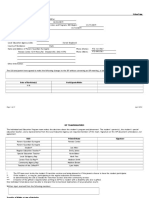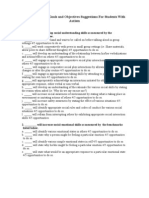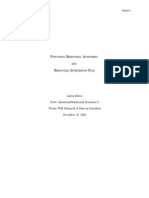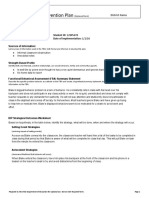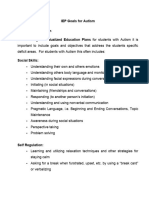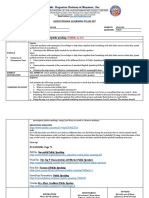Iep Critique
Iep Critique
Uploaded by
api-323033480Copyright:
Available Formats
Iep Critique
Iep Critique
Uploaded by
api-323033480Original Title
Copyright
Available Formats
Share this document
Did you find this document useful?
Is this content inappropriate?
Copyright:
Available Formats
Iep Critique
Iep Critique
Uploaded by
api-323033480Copyright:
Available Formats
IEP Critique Document
IEP document reviewed:
Sabina Smith
Section 1
A statement of present levels of academic achievement and functional performance
1. List all of the assessments used. Briefly state the name and purpose of each assessment.
Why would these assessments be good to use for this student?
Woodcock-Johnson Tests of Achievement-III- this test measures:
Reading achievement, including reading decoding, reading speed, and the ability to
comprehend connected discourse while reading, reading comprehension, vocabulary, and
reasoning
Sight vocabulary, phonics, and structural analysis
Linguistic competency, listening ability, and comprehension
Expressive vocabulary, reasoning, listening comprehension, and memory
Listening ability and verbal comprehension
Linguistic competency and expressive vocabulary
Math achievement, including problem solving, number facility, automaticity, and
reasoning
Basic mathematical skills, including computational skills and automaticity with basic
math facts
Mathematical knowledge and reasoning, including problem solving, analysis, reasoning,
and vocabulary
Written language achievement, including spelling of single-word responses, fluency of
production, and quality of expression
Spelling single-word responses and identifying and correcting errors in spelling,
punctuation, capitalization, and word usage
Meaningful written expression and fluency
Scientific, social studies, and cultural knowledge
Basic achievement skills, including reading decoding, math calculation, and spelling of
single-word responses
Overall academic fluency
Ability to apply academic skills to academic problems
Proficiency with phonic generalizations and common orthographic patterns in both
decoding and encoding
Overall performance across various achievement domains
Woodcock-Johnson Tests of Achievement-III is very good for this student because it measures
every aspect of education and gives a child chance to show what their straight is and weaknesses.
WISC- IV- the Wechsler Intelligence Scale for Children is an IQ test that is administered to
children ages 6 -16. No writing or reading ability is needed of the child that is taking the
Wechsler Intelligence Scale for Children. Once it has been completed, the WISC test produces
an IQ score. It is really good to know students ability to learn and IQ so I think that this test is
also very good for this student.
Leytham 2014
IEP Critique Document
2. When writing about the students current performance, it is good practice to start with
positive statements, followed by deficit statements, then a statement about why the deficit
is important to address, and finally a statement about what will be done. For example,
Billy can count to 10. However, he is still having difficulty with skip-counting. This skill
is important to learn because it will help him understand the number system. Billy will
need to work on skip-counting by 2s and 5s. This provides his current performance,
where he needs to go, and why. Find this section in the IEP that you are critiquing. How
does the narrative address the students performance? In a positive light? Mostly negative
comments? Select one paragraph and rewrite it using the format given above.
Sal can answer comprehension questions based on orally read material; however he is slow and
hesitant when reading orally, especially when he is reading material that contains multi-syllable
words. He has difficulty recalling details, making inferences, and drawing conclusions .He can
write simple sentences, but he has difficulty stringing sentences together to form a paragraph on
a given topic. He digresses from the topic as his thoughts wander. Sals written work shows that
he has spelling errors of basic sight words, invented spellings, and limited punctuation skills. He
understands and can compose topic sentences, detail sentences, and concluding sentences.
3. When writing about the effect of the students involvement in the general education
curriculum, it is good practice to begin with a description about what typical students in
that grade level are expected to do. This information can be found on the state department
of education website. After stating what typical students can do in that grade level, a
statement about why the student is unable to access the general education curriculum
should follow. Look at this section in the IEP that you are critiquing. Is it thoroughly
written in a narrative format that addresses how typical students should perform and why
the particular student is unable to perform? Select one paragraph and rewrite it.
Student in Sal sage should complete reading and writing assignment in specify time frame those
assignments are difficult for him to complete on time Sal has trouble understand what he reads,
and express his thoughts meaningfully on writing assignments. His social and emotional
problems interfere with his ability to participate on group assignments with other students, to
follow teacher directives, and to respond appropriately when criticized by others.
Leytham 2014
IEP Critique Document
Section 2
A statement of measurable annual goals.
1. When writing goals and benchmarks, one must remember to make sure that they are
measureable. This means that each goal/benchmark addresses: (1) direction (increase,
maintain, decrease, etc.); (2) area of need (reading, social skills, etc.); (3) level of
attainment or success (grade level, accuracy, etc.); (4) how progress will be measured;
and (5) the setting and responsible staff that will teach it. Look at the annual goals. Are
they discussed in the present levels? Are they related to state standards? Are they written
in measurable terms? Give an example of a goal from the IEP.
Need area: Reading - State standard: Level: Grade 05
R1.4. Acquire and use new vocabulary in relevant contexts.
Need area: Writing - State standard: Writing Process Level: Grade 04
W1.2. Create a first draft containing the necessary elements for a specific purpose
Need area: Social/emotional/behavioral - State standard: Workplace - Skill Level: Low
Essentials
4WP-E1. Identify ways to build mutual trust and respect and develop an action plan for
negotiating concerns.
Need area: Social/emotional/behavioral - State standard: Physical Activity Level: High Essentials
5PA-E3. Cooperate with a group to achieve group goals in competitive as well as
cooperative settings.
2. Look at the benchmarks for each goal. When writing benchmarks, they should be in
sequential order, contain concrete timeframe, and adhere to the principles discussed
above. Are the benchmarks related to the goals? Are they written in sequential format?
Give an example of the benchmarks for a goal.
Only one of the goals has benchmarks. Those benchmarks are related to the goal and are written
in sequential form:
Organize writing into a logical sequence that is clear to the audience.
Organize writing into a logical sequence that is clear to the audience.
Use a prewriting plan to develop a draft with main idea(s) and supporting details.
Use a prewriting plan to develop a draft with main idea(s) and supporting details.
The only discrepancy is that they keep repeating it.
IEP Critique Document
Section 3
A description of how the child's progress toward meeting the annual goals will be measured
1. What is the method for reporting the student's progress toward meeting his/her annual
goal(s)? Check all that apply.
IEP Goals Page
District Report Card
Specialized Progress Report
Parent Conferences
Other: there are no methods listed on IEP report.
2. How often will the parent be notified of the student's progress?
Quarterly
Semester
Trimester
Other: not listed
IEP Critique Document
Section 4
Special Education and Related Services
An IEP must include a statement of the special education and related services and supplementary
aids and services, based on peer-reviewed research to the extent practicable, to be provided to the
child, or on behalf of the child, and a statement of the program modifications or supports for
school personnel that will be provided for the child.
1. What types of special education services does this student receive? Check each service
that is indicated in the IEP.
Written language
Math
Reading
Social skills
Organization Skills
Other:
2. Are the special education services indicated on this IEP discussed in the present levels of
academic achievement and functional performance section?
Yes
3. What types of related services does this student receive? Check each service that is
indicated on the IEP.
Speech / Language Therapy
Occupational Therapy
Physical Therapy
Adapted Physical education
Audiology Services
Psychological Services
Transportation
School Nurse Services
Other: counseling
4. Look at the amount of time the related service(s) is/are provided. Do you think it is
enough? If, "No", explain why you think it is not enough.
I think counseling weekly for 60 min it is planet of time, and school transportation is also great
every day to socialize.
IEP Critique Document
Section 5
Justification for Placement
An IEP must include an explanation of the extent, if any, to which the child will not participate
with nondisabled children in the regular class and in the activities. This section is to justify why a
child is being placed in a particular setting. Look for a place in the IEP where it discusses the
least restrictive environment (i.e., regular class, resource room, self-contained, residential
facility, hospital, etc.).
1. What placement has been selected for the student to be educated in?
General Education Classroom
General Education Classroom with Consultation
General Education Classroom with Supplementary Instruction and Services
Resource Room
Separate Classroom
Separate School
Residential School
Homebound
Hospital
2. Look at the justification paragraph. Read it and try to see if the following questions are
answered. Select, "Yes" or "No" for each question.
What specialized instruction, modifications of the curriculum, or
Yes
No
accommodations does this student require to participate in the general
education environment?
Why can't the specialized instruction, modifications, or accommodations be
provided in the general education environment?
Describe the student's unique needs and why those needs cannot be met in a
general education environment.
Describe the non-academic benefits (i.e., self-esteem, social, behavioral,
observational learning effect, communication) that this student failed to
demonstrate in the general education environment.
IEP Critique Document
Describe how this student's needs impact the teaching and learning in the
general education environment.
Describe any potential harmful effect of this recommended placement.
IEP Critique Document
Section 6
Accommodations and Modifications
An IEP must include (a) a statement of any individual appropriate accommodations that are
necessary to measure the academic achievement and functional performance of the child on State
and district-wide assessments and (b) whether or not the child qualifies to take an alternative
assessment.
1. What accommodations are listed? Do they seem appropriate? Were they discussed in the
present levels? Remember, accommodations provide access to the curriculum.
Simplified curriculum, preferential seating, simple clearly stated instructions, Sequential units of
instruction, Extra practice on lessons, Behavior plan or contract
yes those changes are appropriate.
2. What modifications are listed? Do they seem appropriate? Were they discussed in the
present levels? Remember, modifications provide change the curriculum.
No modification.
IEP Critique Document
Section 7
Dates, Frequency, Location, and Duration
An IEP must include (a) the projected date for the beginning of the services and modifications
and (b) the anticipated frequency, location, and duration of those services and modifications.
1. What eligibility category does the student have?
Learning Disabilities
Speech or Language Impairments
Other Health Impairment
Intellectual Disability
Emotional Disturbance
Autism
Multiple Disabilities
Developmental Delay
Hearing Impairment
Orthopedic Impairment
Visual Impairment
Traumatic Brain Injury
Deaf-Blindness
2. Who is required to attend an IEP meeting? Check each required member. Remember, just
because someone is invited to the IEP meeting doesn't mean that he/she is "required" to
be there. Read carefully p. 60.
The parents of a child with a disability.
At least one regular education teacher.
At least one special education teacher.
A local education agency representative.
An individual who can interpret the IEP (this person may be someone already
listed above).
Other individuals who have been invited by the parents or the local education
agency.
Whenever appropriate, the child with a disability.
3. In looking at the special education and related services section, do the projected dates
cover an entire year?
No it covers 7 months from 10/01/2004- 5/20/2005
4. Would you know exactly where, when, and for how long the special education and
related services should be provided?
Yes we do know.
IEP Critique Document
Additional Factors to be Considered
The following factors must also be considered when creating an IEP.
1. After reading the strengths of the child, what is your perception of him/her?
It looks like student is more interested in science subject than English. Math is his strong side.
Problem with English could be an effect of parent main language being Spanish.
2. Are any parental concerns listed? What are they? What does this tell you that the parent
thinks is important?
Students parents speak English, but their primary language is Spanish. Students teachers report
that the parents do not seem to fully understand the seriousness of his problems in school. The
parents appear to be supportive of his education, but they do not attend school conferences. They
have reported concerns that child is not learning to read and that other children pick on him.
3. Indicate whether or not the child has any of the following special factors:
Behavior that impedes his/her learning or the learning of others
Limited English proficient
Is blind or visually impaired
Is deaf or hard of hearing
Requires assistive technology
Yes
No
You might also like
- GoalBankIEPVersion9NY PDFDocument173 pagesGoalBankIEPVersion9NY PDFlirebien94% (16)
- Functional Behavior Assessment and Behavior Intervention PlanDocument14 pagesFunctional Behavior Assessment and Behavior Intervention Planapi-301956295100% (2)
- Iep RedactedDocument11 pagesIep Redactedapi-503401778No ratings yet
- Turning Five Student Progress ReportDocument2 pagesTurning Five Student Progress ReportBryan Peterson100% (2)
- Iep Example TransitionDocument13 pagesIep Example Transitionapi-302270549No ratings yet
- Iep Cheat SheetDocument11 pagesIep Cheat Sheetapi-343665078100% (3)
- Understanding Assessment in the Special Education Process: A Step-by-Step Guide for EducatorsFrom EverandUnderstanding Assessment in the Special Education Process: A Step-by-Step Guide for EducatorsRating: 4.5 out of 5 stars4.5/5 (5)
- Iep TemplateDocument13 pagesIep Templateapi-301094873100% (1)
- Lugioyo, Brian - Martin Bucer's Doctrine of Justification PDFDocument271 pagesLugioyo, Brian - Martin Bucer's Doctrine of Justification PDFLa Esquina del Movimiento100% (3)
- Questions I Have Been AskedDocument10 pagesQuestions I Have Been Askedapi-301975320No ratings yet
- Individualized Education Program (Iep) : Page 1 of 21 April 2014Document21 pagesIndividualized Education Program (Iep) : Page 1 of 21 April 2014api-454875755No ratings yet
- Educational Achievement ReportDocument15 pagesEducational Achievement Reportapi-307591226100% (1)
- Iep Case StudyDocument16 pagesIep Case Studyapi-316958999No ratings yet
- IepformDocument9 pagesIepformapi-273441949No ratings yet
- Case Study IepDocument6 pagesCase Study Iepapi-168258709No ratings yet
- Sample Social IEP GoalsDocument3 pagesSample Social IEP Goalsteamirene13No ratings yet
- Safety Plan Outline: XXXXXDocument5 pagesSafety Plan Outline: XXXXXapi-290018716No ratings yet
- Iep Process Parents Brochure LTM 631Document2 pagesIep Process Parents Brochure LTM 631api-220599703100% (2)
- The Iep Fact Sheet 1Document3 pagesThe Iep Fact Sheet 1api-569225521No ratings yet
- Younger School Age 1Document14 pagesYounger School Age 1api-323033480No ratings yet
- Assignment 1Document10 pagesAssignment 1api-254146673No ratings yet
- IepcasestudyDocument13 pagesIepcasestudyapi-285055482No ratings yet
- Student Support Plan Pre Referral 7 8 14Document10 pagesStudent Support Plan Pre Referral 7 8 14api-262427772No ratings yet
- Spe 269 IepDocument15 pagesSpe 269 IepAmanda EvansNo ratings yet
- IEPDocument30 pagesIEPCourtney RaiaNo ratings yet
- Iep Kelsey OlsonDocument15 pagesIep Kelsey Olsonapi-242024655100% (1)
- Iep PracticeDocument5 pagesIep Practiceapi-317025674No ratings yet
- Iep Form Goal Page Review 1Document15 pagesIep Form Goal Page Review 1api-215679959No ratings yet
- IepDocument10 pagesIepapi-272760222100% (2)
- Assessment ReportDocument4 pagesAssessment Reportapi-271058409No ratings yet
- Iep Final KsparksDocument28 pagesIep Final Ksparksapi-227768635No ratings yet
- Iep PaperDocument3 pagesIep Paperapi-283801172No ratings yet
- Fba Abby Veldink Brooke Ebels Nikki Walsh Caitlin MaasDocument4 pagesFba Abby Veldink Brooke Ebels Nikki Walsh Caitlin Maasapi-354766325No ratings yet
- Running Head: IEP CASE STUDY 1Document14 pagesRunning Head: IEP CASE STUDY 1api-273876747No ratings yet
- Fba Report-3-1Document4 pagesFba Report-3-1api-302642402No ratings yet
- Iep Overview EssayDocument4 pagesIep Overview Essayapi-530012202No ratings yet
- Fba Form 1 - Summer ParDocument2 pagesFba Form 1 - Summer Parapi-302628458No ratings yet
- Se 515 Assessment ReportDocument6 pagesSe 515 Assessment Reportapi-521673040No ratings yet
- Functional Goals: See It in Action: ShariaDocument19 pagesFunctional Goals: See It in Action: Shariameet76No ratings yet
- Fba BipDocument3 pagesFba Bipapi-218772826No ratings yet
- Sample IEPDocument6 pagesSample IEPAshar AkbarNo ratings yet
- Iep ManualDocument38 pagesIep Manualapi-30264868850% (2)
- Functional Behavior AnalysisDocument12 pagesFunctional Behavior Analysisjoelwrig8812No ratings yet
- Individualized Education Program: 4/20/2003 2013 - 2014 4th - 5thDocument11 pagesIndividualized Education Program: 4/20/2003 2013 - 2014 4th - 5thapi-239518461No ratings yet
- Progress Report Comments For SLPsDocument2 pagesProgress Report Comments For SLPsLaura DicksonNo ratings yet
- IEP Goals PDFDocument6 pagesIEP Goals PDFEmmy Vesta75% (4)
- Final Fba-BipDocument15 pagesFinal Fba-Bipapi-271877599100% (1)
- Final IepDocument12 pagesFinal Iepapi-494901445100% (1)
- Sample Case StudypdfDocument12 pagesSample Case StudypdfSITI AISYAH ABD RANINo ratings yet
- Dyslexia Basics and The O-G Approach NewDocument42 pagesDyslexia Basics and The O-G Approach NewSueNo ratings yet
- Iep ProjectDocument16 pagesIep Projectapi-494142720No ratings yet
- Wells IepDocument6 pagesWells Iepapi-341099160No ratings yet
- Muskegon Area ISD - Functional Assessment/Behavior Intervention FormDocument3 pagesMuskegon Area ISD - Functional Assessment/Behavior Intervention Formapi-209129232No ratings yet
- Nabulla, R (SAMPLE 2017)Document18 pagesNabulla, R (SAMPLE 2017)mariya khan100% (1)
- HandoutsDocument43 pagesHandoutsAna Luiza FerreiraNo ratings yet
- FBA and BIPDocument27 pagesFBA and BIPLisa SmithNo ratings yet
- Edu 361 BipDocument5 pagesEdu 361 Bipapi-270441019No ratings yet
- SLP Student Intake Form Referral Consent Case HistoryDocument3 pagesSLP Student Intake Form Referral Consent Case Historyapi-617678622No ratings yet
- Referral For EvaluationDocument4 pagesReferral For Evaluationapi-272673186No ratings yet
- IEP Goals For AutismDocument10 pagesIEP Goals For AutismmitraseptianyNo ratings yet
- Virginia Department of Education's Sample IEP Form: For Use With Students Up To Age Thirteen, As AppropriateDocument28 pagesVirginia Department of Education's Sample IEP Form: For Use With Students Up To Age Thirteen, As AppropriateJohn JonesNo ratings yet
- Classroom Management Plan 6 Grade Middle School Math: by Sabina Smith EDU 299Document6 pagesClassroom Management Plan 6 Grade Middle School Math: by Sabina Smith EDU 299api-323033480No ratings yet
- Praxis Analysis 1 1Document2 pagesPraxis Analysis 1 1api-323033480No ratings yet
- Edu220 A4Document5 pagesEdu220 A4api-323033480No ratings yet
- Edu220 A6Document5 pagesEdu220 A6api-323033480No ratings yet
- Edu220 A5Document5 pagesEdu220 A5api-323033480No ratings yet
- Edu 220 A 1Document3 pagesEdu 220 A 1api-323033480No ratings yet
- Standard Lesson PlanDocument4 pagesStandard Lesson Planapi-323033480No ratings yet
- Edu220 A3Document5 pagesEdu220 A3api-323033480No ratings yet
- Edu220 A2Document4 pagesEdu220 A2api-323033480No ratings yet
- TimelineDocument6 pagesTimelineapi-323033480No ratings yet
- ExelDocument6 pagesExelapi-323033480No ratings yet
- Sabina SmithDocument4 pagesSabina Smithapi-323033480No ratings yet
- ClassDocument2 pagesClassapi-323033480No ratings yet
- First 2Document1 pageFirst 2api-323033480No ratings yet
- EDU 280 Sabina SmithDocument4 pagesEDU 280 Sabina Smithapi-323033480No ratings yet
- On The CCSD WebsiteDocument2 pagesOn The CCSD Websiteapi-323033480No ratings yet
- Award 2Document1 pageAward 2api-323033480No ratings yet
- Project 2Document1 pageProject 2api-323033480No ratings yet
- ACKS Axioms 01Document25 pagesACKS Axioms 01sullivbt100% (5)
- (Stephen Parkin) An Applied Visual Sociology PictDocument316 pages(Stephen Parkin) An Applied Visual Sociology PictAlfredo CarbalhoNo ratings yet
- Chapter 11 Sec 4Document15 pagesChapter 11 Sec 4api-172746693No ratings yet
- The Banality of Digital Reputation A Visual EthnogDocument10 pagesThe Banality of Digital Reputation A Visual EthnogsaraNo ratings yet
- DLL Week 4Document4 pagesDLL Week 4mark decena0% (1)
- Hewlett Packard HP-35s Training AidsDocument290 pagesHewlett Packard HP-35s Training Aidscstuhlmueller100% (2)
- Module 1 de PDFDocument18 pagesModule 1 de PDFDhruthi VenkateshNo ratings yet
- Collaborative Public Management - O'Leary and Vij (ASPA Conf 2012)Document34 pagesCollaborative Public Management - O'Leary and Vij (ASPA Conf 2012)John Kamensky100% (2)
- Al-Ahkam As-Sultaniyyah - The Laws of Islamic Governance PDFDocument382 pagesAl-Ahkam As-Sultaniyyah - The Laws of Islamic Governance PDFabdulqayyum100% (1)
- QA QuranDocument55 pagesQA QuranSharif786786100% (2)
- SFBT - OscarDocument25 pagesSFBT - OscarJose100% (1)
- QuestionnaireDocument3 pagesQuestionnaireharshita khadayteNo ratings yet
- Chapter IVDocument17 pagesChapter IVHoang Thi Hai YenNo ratings yet
- Horne & Lowe 1996 JEAB Naming and Other Symbolic Behavior PDFDocument57 pagesHorne & Lowe 1996 JEAB Naming and Other Symbolic Behavior PDFCamilo HurtadoNo ratings yet
- Public OpinionDocument4 pagesPublic OpinionuzairNo ratings yet
- Dunn Test PDFDocument6 pagesDunn Test PDFAlonso 1No ratings yet
- Chekhov EssayDocument73 pagesChekhov EssayasdqefdadasNo ratings yet
- Miggins Adult Animal Entertainment Business PlanDocument6 pagesMiggins Adult Animal Entertainment Business PlanSunshine419No ratings yet
- LP Observe 3 RD QuarterDocument3 pagesLP Observe 3 RD QuarterHarlyn Grace CenidoNo ratings yet
- Eigenvalues, Peres' Separability Condition, and EntanglementDocument5 pagesEigenvalues, Peres' Separability Condition, and EntanglementhitherehiNo ratings yet
- St. Mary's Catholic Church: Mass ScheduleDocument2 pagesSt. Mary's Catholic Church: Mass ScheduleSaintMarysMaltaNo ratings yet
- Vedanta Madhuryam 1.1Document24 pagesVedanta Madhuryam 1.1RAMESHBABUNo ratings yet
- Ross - The Right and The GoodDocument34 pagesRoss - The Right and The GoodMechelle Mae VercideNo ratings yet
- Definition of DesignDocument4 pagesDefinition of DesignTehreem Asim100% (2)
- English 10 Playlist Week 8Document6 pagesEnglish 10 Playlist Week 8Juvelyn AbuganNo ratings yet
- New Microsoft Word DocumentDocument4 pagesNew Microsoft Word DocumentVijaya RaghavNo ratings yet
- Ec. de Martin PDFDocument17 pagesEc. de Martin PDFMaggyBalcazarNo ratings yet
- 10 Chapter 4Document18 pages10 Chapter 4EASSANo ratings yet










